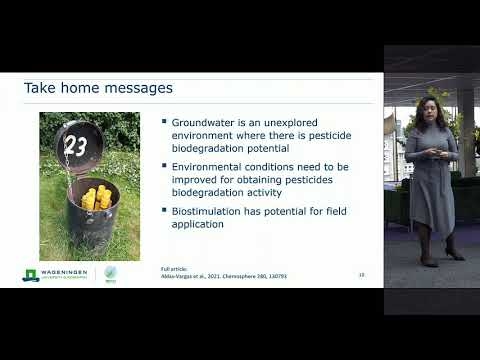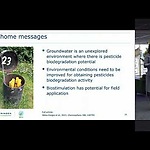Natural intrinsic biodegradation processes in groundwater can be limited due to (1) supply of electron acceptors, (2) growth substrate, (3) absence of degrading. To assess pesticide biodegradation capacity of field microorganisms, groundwater samples were taken from two monitoring wells located at the north-east of The Netherlands, at five different depths ranging from 13 to 54 m below ground level. Biodegradation of the MPs BAM, MCPP and 2,4-D was assessed in mesocosms with groundwater samples, either without amendment, or with amendment with electron acceptor (nitrate or oxygen) and/or carbon substrate (dissolved organic carbon (DOC). Oxygen+DOC was the most successful amendment resulting in complete biodegradation of 2,4-D in all mesocosms after 42 days.
DOC was most likely used as a growth substrate that enhanced co-metabolic 2,4-D degradation with oxygen as electron acceptor. Different biodegradation rates were observed per groundwater sample. Overall, microorganisms from the shallow aquifer had faster biodegradation rates than those from the deep aquifer. Higher microbial activity was also observed in terms of CO2 production in the mesocosms with shallow groundwater. Longer exposition time to both DOC and MPs could have resulted in microbial adaptation and better biodegradation in shallow samples. Understanding field biodegradation capacity is a key step towards developing further bioremediation-based technologies. Our results show that biostimulation has real potential as a technology for remediating MPs in aquifers in order to ensure safe drinking production.
Source: Aldas-Vargas, A. 2021. Biostimulation as a tool to assess pesticide biodegradation capacity of microorganisms in groundwater. Quality assurance, Biodegradation and tools for its assessment. Risk & Resilience. AIWW 2021.
In-person Conference
Source: YouTube - Biostimulation as a tool to assess pesticide biodegradation

